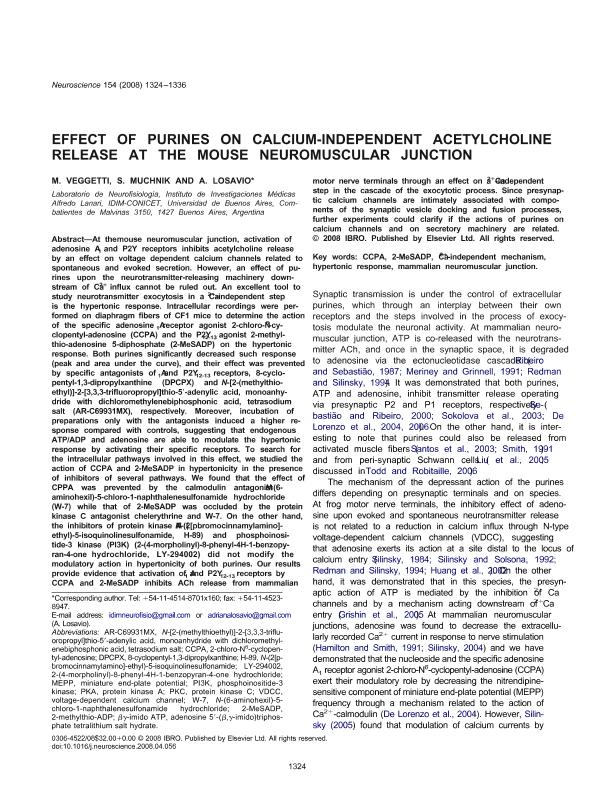Mostrar el registro sencillo del ítem
dc.contributor.author
Veggetti, Mariela Iris

dc.contributor.author
Muchnik, Salomon

dc.contributor.author
Losavio, Adriana Silvia

dc.date.available
2020-05-14T15:57:06Z
dc.date.issued
2008-07
dc.identifier.citation
Veggetti, Mariela Iris; Muchnik, Salomon; Losavio, Adriana Silvia; Effect of purines on calcium-independent acetylcholine release at the mouse neuromuscular junction; Pergamon-Elsevier Science Ltd; Neuroscience; 154; 4; 7-2008; 1324-1336
dc.identifier.issn
0306-4522
dc.identifier.uri
http://hdl.handle.net/11336/105121
dc.description.abstract
At the mouse neuromuscular junction, activation of adenosine A1 and P2Y receptors inhibits acetylcholine release by an effect on voltage dependent calcium channels related to spontaneous and evoked secretion. However, an effect of purines upon the neurotransmitter-releasing machinery downstream of Ca2+ influx cannot be ruled out. An excellent tool to study neurotransmitter exocytosis in a Ca2+-independent step is the hypertonic response. Intracellular recordings were performed on diaphragm fibers of CF1 mice to determine the action of the specific adenosine A1 receptor agonist 2-chloro-N6-cyclopentyl-adenosine (CCPA) and the P2Y12-13 agonist 2-methylthio-adenosine 5′-diphosphate (2-MeSADP) on the hypertonic response. Both purines significantly decreased such response (peak and area under the curve), and their effect was prevented by specific antagonists of A1 and P2Y12-13 receptors, 8-cyclopentyl-1,3-dipropylxanthine (DPCPX) and N-[2-(methylthioethyl)]-2-[3,3,3-trifluoropropyl]thio-5′-adenylic acid, monoanhydride with dichloromethylenebiphosphonic acid, tetrasodium salt (AR-C69931MX), respectively. Moreover, incubation of preparations only with the antagonists induced a higher response compared with controls, suggesting that endogenous ATP/ADP and adenosine are able to modulate the hypertonic response by activating their specific receptors. To search for the intracellular pathways involved in this effect, we studied the action of CCPA and 2-MeSADP in hypertonicity in the presence of inhibitors of several pathways. We found that the effect of CPPA was prevented by the calmodulin antagonist N-(6-aminohexil)-5-chloro-1-naphthalenesulfonamide hydrochloride (W-7) while that of 2-MeSADP was occluded by the protein kinase C antagonist chelerythrine and W-7. On the other hand, the inhibitors of protein kinase A (N-(2[pbromocinnamylamino]-ethyl)-5-isoquinolinesulfonamide, H-89) and phosphoinositide-3 kinase (PI3K) (2-(4-morpholinyl)-8-phenyl-4H-1-benzopyran-4-one hydrochloride, LY-294002) did not modify the modulatory action in hypertonicity of both purines. Our results provide evidence that activation of A1 and P2Y12-13 receptors by CCPA and 2-MeSADP inhibits ACh release from mammalian motor nerve terminals through an effect on a Ca2+-independent step in the cascade of the exocytotic process. Since presynaptic calcium channels are intimately associated with components of the synaptic vesicle docking and fusion processes, further experiments could clarify if the actions of purines on calcium channels and on secretory machinery are related.
dc.format
application/pdf
dc.language.iso
eng
dc.publisher
Pergamon-Elsevier Science Ltd

dc.rights
info:eu-repo/semantics/openAccess
dc.rights.uri
https://creativecommons.org/licenses/by-nc-sa/2.5/ar/
dc.subject
CCPA
dc.subject
2-MeSADP
dc.subject
HYPERTONIC RESPONSE
dc.subject
MAMMALIAN NEUROMUSCULAR JUNCTION
dc.subject.classification
Neurociencias

dc.subject.classification
Medicina Básica

dc.subject.classification
CIENCIAS MÉDICAS Y DE LA SALUD

dc.title
Effect of purines on calcium-independent acetylcholine release at the mouse neuromuscular junction
dc.type
info:eu-repo/semantics/article
dc.type
info:ar-repo/semantics/artículo
dc.type
info:eu-repo/semantics/publishedVersion
dc.date.updated
2020-05-05T16:07:51Z
dc.journal.volume
154
dc.journal.number
4
dc.journal.pagination
1324-1336
dc.journal.pais
Estados Unidos

dc.journal.ciudad
Amsterdam
dc.description.fil
Fil: Veggetti, Mariela Iris. Consejo Nacional de Investigaciones Científicas y Técnicas. Oficina de Coordinación Administrativa Houssay. Instituto de Investigaciones Médicas. Universidad de Buenos Aires. Facultad de Medicina. Instituto de Investigaciones Médicas; Argentina
dc.description.fil
Fil: Muchnik, Salomon. Consejo Nacional de Investigaciones Científicas y Técnicas. Oficina de Coordinación Administrativa Houssay. Instituto de Investigaciones Médicas. Universidad de Buenos Aires. Facultad de Medicina. Instituto de Investigaciones Médicas; Argentina
dc.description.fil
Fil: Losavio, Adriana Silvia. Consejo Nacional de Investigaciones Científicas y Técnicas. Oficina de Coordinación Administrativa Houssay. Instituto de Investigaciones Médicas. Universidad de Buenos Aires. Facultad de Medicina. Instituto de Investigaciones Médicas; Argentina
dc.journal.title
Neuroscience

dc.relation.alternativeid
info:eu-repo/semantics/altIdentifier/doi/http://dx.doi.org/10.1016/j.neuroscience.2008.04.056
dc.relation.alternativeid
info:eu-repo/semantics/altIdentifier/url/https://www.sciencedirect.com/science/article/abs/pii/S0306452208006556
Archivos asociados
